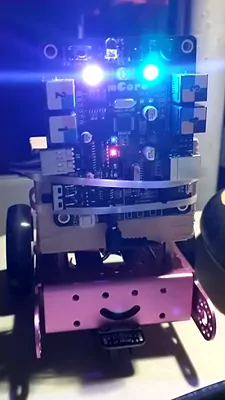I wanted to document this chat-controlled robot I made for Babycastles' LOLCAM📸 that accepts a predefined set of commands like a character in an RPG party 〰 commands like walk, spin, bash, drill. It can also understand donut, worm, ring, wheels, and more. The signal for each command is transmitted as a 24-bit value over infrared using two Arduinos, one with an infrared LED, and the other with an infrared receiver. I built the transmitter circuit, and the receiver was built into the board that came with the mBot robot kit. The infrared library IRLib2 was used to transmit and receive the data as a 24-bit value.

fig. 1.1: the LEDs don't have much to do with this post!
I wanted to control the robot the way the infrared remote that came with the mBot controlled it, but the difference would be that since we would be getting input from the computer, it would be like having a remote with an unlimited amount of buttons. The way the remote works is each button press sends a 24-bit value to the robot over infrared. Inspired by Game Boy Advance registers and tracker commands, I started thinking that if we packed multiple parameters into the 24 bits, it would allow a custom move to be sent each time, so I wrote transmitter and receiver code to process commands that looked like this:
The first command I was able to send with this method that seemed interesting was one that made the mBot do a wheelie.
$ ./send_command.py 15 12 15 1 0 0 0 7 0 1 sending 0xff871fcf...
fig 1.3: sick wheels
A side effect of sending the signal this way is any button on any infrared remote will cause the robot to do something. The star command was actually reverse engineered from looking at the code a random remote button sent. For the robot's debut, it ended up with 15 preset commands (that number is in stonks 📈). I posted a highlights video on social media of how the chat controls turned out.
chat controlled robot ⚡ from cyber #nye 2077 #stream @Babycastles 🤖 #Robots #twitchtv #obs #Arduino #batteries pic.twitter.com/ohKWihpjYH
— the prototype was better (@diskmem) January 4, 2021
This idea was inspired by a remote frog tank LED project I made for Ribbit's Frog World which had a similar concept: press a button, and in a remote location where 🐸 and 🐠 live, an LED would turn on.
fig 2.1: saying hi to froggo remotely using an LED
😇 The transmitter and receiver Arduino programs are available to be copied and modified 😇





